Considering Plants & Pools
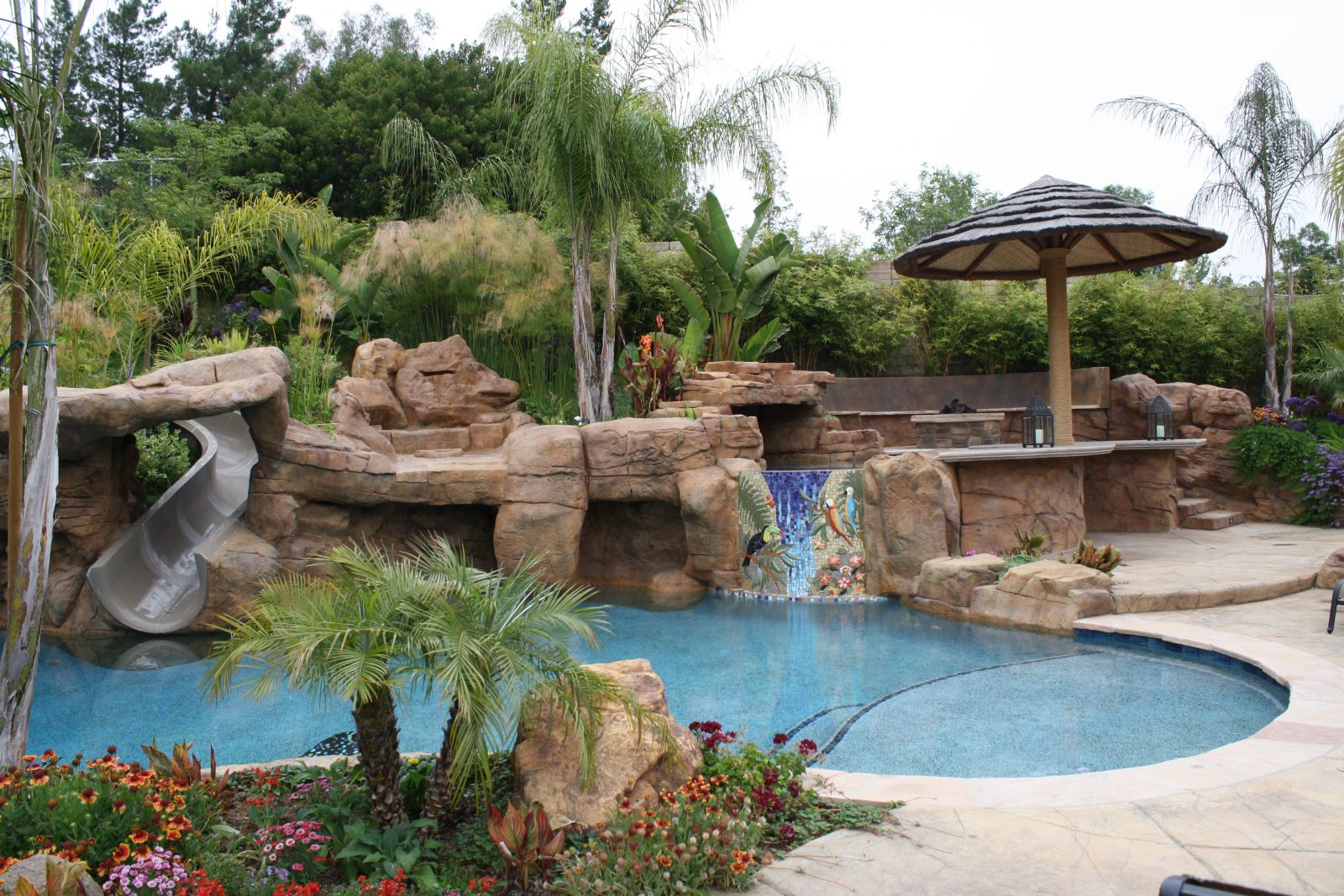
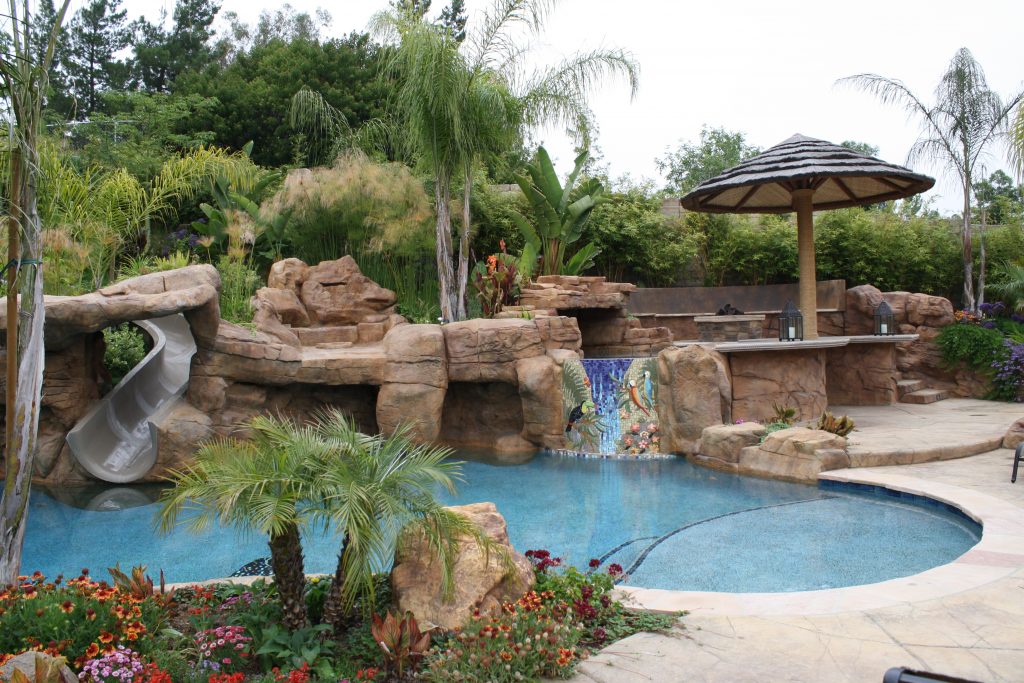
For many watershapers, plants are a mere afterthought. That’s a mistake, says “garden artisan” Scott Cohen. He takes the opposite approach by embracing planted areas as one of the primary design elements in all of his company’s projects. Doing so, he explains here, reduces liability, increases project control and opens up myriad design possibilities.
By Scott Cohen
I started in the home improvement business working with plants. Over the years as our company, The Green Scene in Chatsworth, Calif., moved successfully into custom watershapes and hardscape, the importance of plantings has remained front and center in our work creating beautiful at-home environments.
Plants are, in my view, an indispensable element in any yard, whether it has a watershape in it or not. . If you want your work to stand out as art then you can’t work with only one element of the project (the pool). To really create artistic work you need to be designing most of the elements; the water, hardscape, softscape, lighting, etc. (Imagine if Monet worked only in black and white.) Working in plants enables you to fully complete the scene and avoid the pitfalls of working with outside contractors.
There is a competitive element to it. Clients like to deal with one company and when they talk to us, they will have comprehensive and fully harmonized design. When compared to a competitor that only does pools, we’ll win that project the vast majority of the time.
Make no mistake, there is, indeed, green in the green. We’ll be able to generate revenue and profit from the softscape design and installation, as well as the concrete, pipes and all the elements that go into the watershapes. Furthermore, you avoid the liability exposure that can happen when you don’t control the hardscape and softscape in the yard, and you sidestep any finger pointing that can take place between contractors that are working the same space but are not on the same page.
Yet, for all of the commonsense of working with plantings as a feature on at least equal footing with everything else, the plants have become kind of the forgotten stepchild in the process, at least for many, many companies I’ve encountered over the years. I believe our industry and our clients benefit if watershapers would do more to embrace plants, rather than leaving them to an afterthought.
PLANTING THE SEEDS
The obstacle to working with plants is simply that many people who build watershapes and hardscapes, don’t know much about how to use plants and support them with the design for maximum effect and longevity. Yet, when you do decide to dig in, you’ll not only find advantages mentioned above, but also far greater creative opportunities within each project.
You may even discover that the plany kingdom can become a source of passion and genuine wonderment, an interest that many clients share to varying degrees.
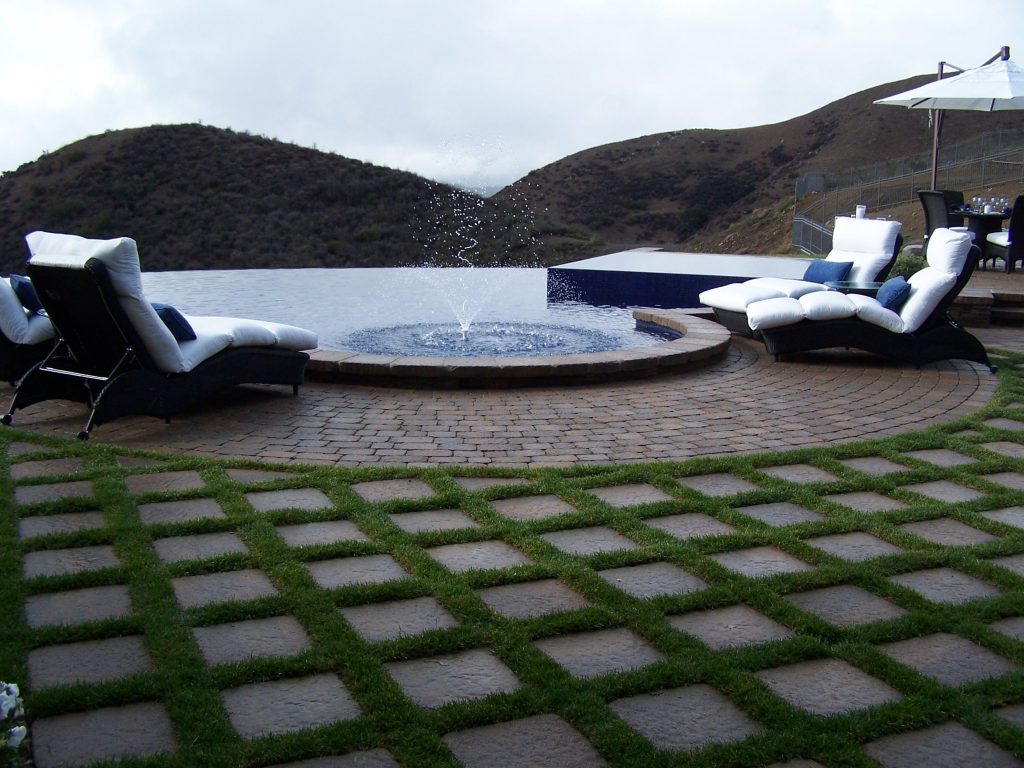
Like anything else in this business, there are a number of important considerations needed to be successful. Still, given the fact that humans have been successfully cultivating plants for food, shelter and pleasure literally since the dawn of civilization, growing the greenery is well within our grasp.
When you’re adding landscaping, you’re working with a variety of aesthetic and functional elements. You’re adding color, texture, fragrance and form that can be used to harmonize with the other features in the design. Plants are soothing and will soften even the most contemporary, stark design and can fit comfortably with any other stylistic motif. You’re also cooling the area, which can be as much as 15 degrees cooler than in the same place without it.
While people perspire to cool themselves, plants “transpire” to cool off, evaporating moisture, they’re like natures little mini misting systems, cooling the surrounding area. This is true of all plants to varying “degrees.” In many projects you’ll be directly adding shade in the form of trees and nothing goes better with shade structures than some forms of plant material.
You can block views, add privacy, buffer noise and add fragrance, and attract birds and insects. With plants you can create destinations, beautify unused space, accentuate garden art, create opportunities for landscape lighting and attract birds, bees and other insects. The botanical possibilities are really only as limited as your imagination.
VERDANT MEASURES
Understanding the design direction is the first step, because the style of the architecture and setting will largely dictate the types of plants you’ll be using. Whether it’s tropical, Mediterranean, neo-classic, contemporary or formal, you want the plants to match the visual motif. For example, I would never use tropical plantings in an Italianate setting and vice versa. Instead, you’d be using olive trees and bougainvillea. On the other hand, when building a lagoon pool, you might turn to palms, ferns and other plants associated with lush, jungle-like settings.
One of the big advantages of taking on plantings in-house is that you can plan for the softscape from the project’s inception. Having an idea of the plants you’ll be using means that you can plan for adequate space, irrigation, drainage, root control, setting the grade, lighting and ultimately using the plants for maximum effect. The planted areas, or containers, become as integral to the plan as the deck areas, outdoor kitchen or the pool itself.
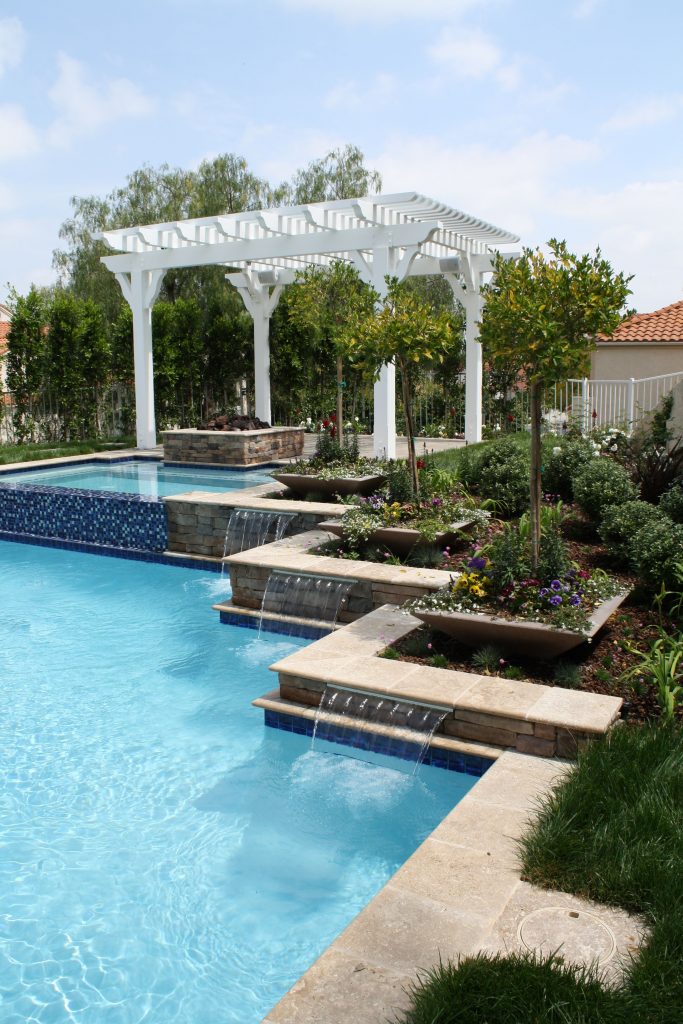
And, when you take on plantings, you control the timing and schedule. Personally, I hate trying to coordinate other contractors and you can wind up facing unnecessary delays. When you handle the whole thing, those problems simply don’t exist.
When you work with plantings on a regular basis, you learn basic measures that prevent problems down the line, and work to ensure maximum growth in the plants themselves and possible damage to surrounding structures.
[] When you’re bringing plants to the edge of the coping, always install a root barrier. “Root Barriers” are 18”-24”plastic interlocking panels that link together and force roots deeper into the earth. By doing so they prevent roots from lifting concrete, coping, tile and invading pool shells. Plant roots can directly damage concrete structures and they will provide a pathway for water. All concrete is porous and root systems can be extremely opportunistic. [] On projects where we’re installing a retaining wall or raised bond beam at the base of a slope, we always waterproof the back of the wall, typically using bentonite, and we install a French drain at the base of the slope and we waterproof the front side. Regardless of the type of planting on the slope, you have to manage the water that can accumulate subsurface from irrigation or precipitation. We take of those measures before installing any of the finish materials on the pool. I’ve seen roots grow between the coping and the bond beam and eject waterline tiles right off the pool walls. [] In planters directly adjacent to pools, we always waterproof the inside of the container, install MiraDrain drainage material, and if there is any kind of plant that will grow significant root structures, we’ll also install a root barrier. Again, root systems can invade the back side of a shotcrete structure enabling water to compromise the structure and even mar the appearance of the plaster finish on the inside of the pool. [] Proper drainage. Not only do you need to install some kind of hydrostatic relief system, i.e., French drains, but they need to be installed correctly. One of the most common mistakes is orienting the holes in the plumbing facing up. That’s a mistake. They are supposed to face down, otherwise the drain doesn’t work. French drains should be covered in a fabric sock, gravel and then all wrapped in geo-fabric forming a “burrito drain”.KNOW YOUR PLANTS
There’s no substitute for understanding basic characteristics of plant types. Some trees, such as Ficus, will develop large and highly invasive root systems that can destroy hardscape. By using a root barrier, you might be able to buy 15 years, but eventually Ficus roots will take over. For that reason, I would never put a Ficus, or a Coral Tree which has the same issue, within 20 feet of a swimming pool, and even at that I’d use a root barrier system. Similarly, there are types of bamboo, which although beautiful, will spread like wild fire if not properly contained.
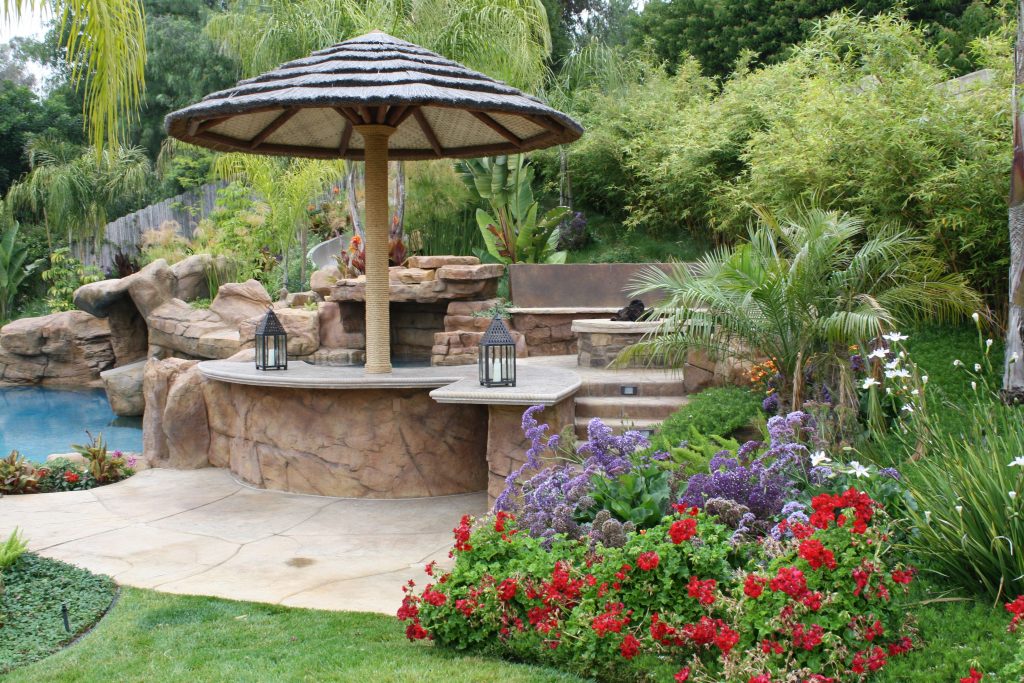
On a completely different level, the proper selection and placement of trees can enhance energy efficiency heating and cooling the home. Deciduous trees, which lose their foliage in winter, can be placed so that they provide shade in the summer, but in the winter when they shed their leaves, they allow available sunlight to warm the house. They enhance efficiency when it’s hot or cold by as much as 15%, when used to maximum effect, which means placing desiduous trees on the southside of the property.
When screening for privacy, evergreens are great because they don’t loose their foliage and will always provide a visual barrier. Some trees provide optimum environments for birds, insects and other types of wildlife. Along parkways, paths and driveways are great places for smaller, flowering trees, creating a beautiful effect. Again, all trees near hardscape should be in parkways boxes with root barriers.
It’s extremely important to know how big a given plant, especially a tree, is going to grow. You need to able to project in your mind what the space will look like and how it will function when the plants reach mature size, which is an important part of the selection and placement process. Knowing mature height, you can work with layered views, with shorter plantings in the foreground and taller ones in the background, adding depth and interest to the scene.
Understanding the shape is another key element. There are round trees, conical trees, columnar, weeping, spreading and open. There are different trunk and limb structures. Oftentimes, I’ll be looking for a specific shape and will pick from the varieties available that will create that form.
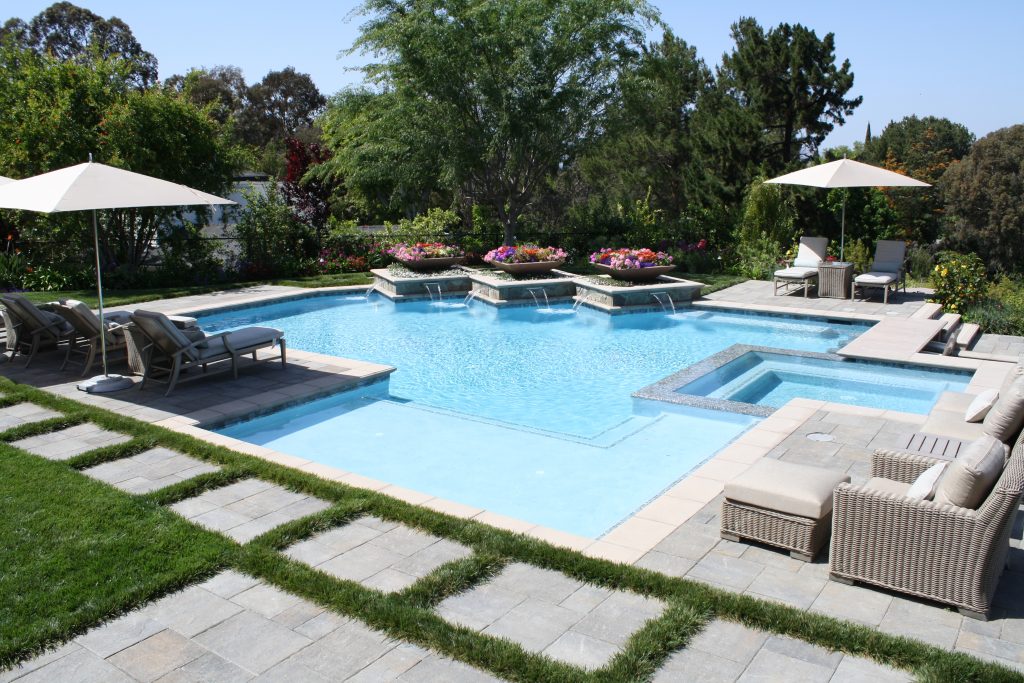
Leaf drop is an obvious consideration around pools especially. Palm trees are suitable for pool environments not just because they evoke tropical or desert settings, they are very light in terms of generating debris and the fronds are easy to clean up. (They also have small root balls and are easy to contain using root barriers.)
Plantings also open the door for various types of pottery, which can be used to wonderful decorative effect. Some plants are far better suited for the confines of a pot that others, so again, knowing the characteristics of plant species is useful.
And, of course, you need to understand a little bit about climate zones and plants that will thrive in a given area. Suppliers can be a big help identifying suitable species.
You don’t have to be a botanist or horticulturalist to work effectively with plants. However, when you move into planted areas as part of your scope of work, you’ll find yourself drawn into the subject. It’s a great topic of discussion with clients, and one that demonstrates your own breadth and depth of knowledge.
This is why I believe that when it comes to including plants, you have everything to gain by going green.
Scott Cohen is a “Garden Artisan” and president of Green Scene Landscaping & Pools, a watershaping design and construction firm based in Chatsworth, Calif. A widely published author and popular speaker, Cohen is known for his gardens that combine outdoor living with inspired artistic details, including the use of copious flowering plants.









